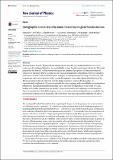Files in this item
Holographic optical traps for atom-based topological Kondo devices
Item metadata
| dc.contributor.author | Buccheri, Francesco | |
| dc.contributor.author | Bruce, Graham David | |
| dc.contributor.author | Trombettoni, Andrea | |
| dc.contributor.author | Cassettari, Donatella | |
| dc.contributor.author | Babujian, Hrachya | |
| dc.contributor.author | Korepin, Vladimir E | |
| dc.contributor.author | Sodano, Pasquale | |
| dc.date.accessioned | 2016-07-19T09:30:08Z | |
| dc.date.available | 2016-07-19T09:30:08Z | |
| dc.date.issued | 2016-07-14 | |
| dc.identifier | 233606822 | |
| dc.identifier | 11f36d4d-6a7d-485a-b325-acf80f7e0509 | |
| dc.identifier | 84979243397 | |
| dc.identifier | 000381877600002 | |
| dc.identifier.citation | Buccheri , F , Bruce , G D , Trombettoni , A , Cassettari , D , Babujian , H , Korepin , V E & Sodano , P 2016 , ' Holographic optical traps for atom-based topological Kondo devices ' , New Journal of Physics , vol. 18 , 075012 . https://doi.org/10.1088/1367-2630/18/7/075012 | en |
| dc.identifier.issn | 1367-2630 | |
| dc.identifier.other | ORCID: /0000-0003-3403-0614/work/27379859 | |
| dc.identifier.other | ORCID: /0000-0003-3571-6642/work/93161385 | |
| dc.identifier.uri | https://hdl.handle.net/10023/9161 | |
| dc.description.abstract | The topological Kondo (TK) model has been proposed in solid-state quantum devices as a way to realize non-Fermi liquid behaviors in a controllable setting. Another motivation behind the TK model proposal is the demand to demonstrate the quantum dynamical properties of Majorana fermions, which are at the heart of their potential use in topological quantum computation. Here we consider a junction of crossed Tonks–Girardeau gases arranged in a star-geometry (forming a Y-junction), and we perform a theoretical analysis of this system showing that it provides a physical realization of the TK model in the realm of cold atom systems. Using computer-generated holography, we experimentally implement a Y-junction suitable for atom trapping, with controllable and independent parameters. The junction and the transverse size of the atom waveguides are of the order of 5 μm, leading to favorable estimates for the Kondo temperature and for the coupling across the junction. Since our results show that all the required theoretical and experimental ingredients are available, this provides the demonstration of an ultracold atom device that may in principle exhibit the TK effect. | |
| dc.format.extent | 12 | |
| dc.format.extent | 1141133 | |
| dc.language.iso | eng | |
| dc.relation.ispartof | New Journal of Physics | en |
| dc.subject | Topological physics | en |
| dc.subject | One-dimensional quantum gases | en |
| dc.subject | Topological quantum computation | en |
| dc.subject | Atomtronics | en |
| dc.subject | Computer generated holography | en |
| dc.subject | QC Physics | en |
| dc.subject | TK Electrical engineering. Electronics Nuclear engineering | en |
| dc.subject | NDAS | en |
| dc.subject | BDC | en |
| dc.subject | R2C | en |
| dc.subject.lcc | QC | en |
| dc.subject.lcc | TK | en |
| dc.title | Holographic optical traps for atom-based topological Kondo devices | en |
| dc.type | Journal article | en |
| dc.contributor.sponsor | EPSRC | en |
| dc.contributor.sponsor | The Leverhulme Trust | en |
| dc.contributor.institution | University of St Andrews. School of Physics and Astronomy | en |
| dc.contributor.institution | University of St Andrews. Condensed Matter Physics | en |
| dc.identifier.doi | https://doi.org/10.1088/1367-2630/18/7/075012 | |
| dc.description.status | Peer reviewed | en |
| dc.identifier.url | http://arxiv.org/abs/1511.06574 | en |
| dc.identifier.grantnumber | GR/T08272/01 | en |
| dc.identifier.grantnumber | RPG-2013-074 | en |
This item appears in the following Collection(s)
Items in the St Andrews Research Repository are protected by copyright, with all rights reserved, unless otherwise indicated.

